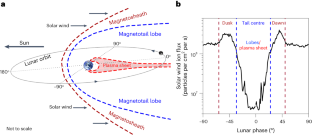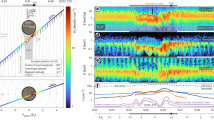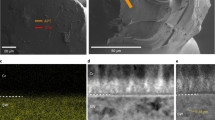Abstract
Solar wind implantation is thought to be one of the primary mechanisms in the formation of water (OH/H2O) on the surface of the Moon and possibly on the surface of other airless bodies. The lunar nearside spends ~27% of its daytime in Earth’s magnetotail where the solar wind flux is reduced by as much as ~99%. However, no correlated decrease in surficial water content has yet been seen on the lunar nearside. Here we report abundance observations of lunar surficial water on the nearside at different stages during the Moon’s passage through Earth’s magnetotail. We find that the water abundance at lunar mid-latitudes substantially increases in the dusk and dawn magnetosheath when the solar wind flux increases, yet remains nearly constant across the central magnetotail. We suggest that although we have confirmed the importance of the solar wind as a major source of fast water production on the Moon, hitherto unobserved properties of the plasma sheet properties may also play an important role.
This is a preview of subscription content, access via your institution
Access options
Access Nature and 54 other Nature Portfolio journals
Get Nature+, our best-value online-access subscription
$29.99 / 30 days
cancel any time
Subscribe to this journal
Receive 12 digital issues and online access to articles
$119.00 per year
only $9.92 per issue
Buy this article
- Purchase on Springer Link
- Instant access to full article PDF
Prices may be subject to local taxes which are calculated during checkout




Similar content being viewed by others
Data availability
The Moon Mineralogy Mapper L1B data are available at https://pds-imaging.jpl.nasa.gov/volumes/m3.html. The derived water maps and their associated local time and lunar phases are archived to the NASA Planetary Data System Cartography and Imaging Sciences node at https://doi.org/10.17189/gmce-w279.
References
Watson, K., Murray, B. C. & Brown, H. The behavior of volatiles on the lunar surface. J. Geophys. Res. 66, 3033–3045 (1961).
Li, S. & Garrick-Bethell, I. Surface water at lunar magnetic anomalies. Geophys. Res. Lett. 46, 14318–14327 (2019).
Sunshine, J. M. et al. Temporal and spatial variability of lunar hydration as observed by the Deep Impact spacecraft. Science 326, 565–568 (2009).
Pieters, C. M. et al. Character and spatial distribution of OH/H2O on the surface of the Moon seen by M3 on Chandrayaan-1. Science 326, 568–572 (2009).
Clark, R. N. Detection of adsorbed water and hydroxyl on the Moon. Science 326, 562–564 (2009).
Greer, J. et al. Atom probe tomography of space-weathered lunar ilmenite grain surfaces. Meteorit. Planet. Sci. 55, 426–440 (2020).
Liu, Y. et al. Direct measurement of hydroxyl in the lunar regolith and the origin of lunar surface water. Nat. Geosci. 5, 779–782 (2012).
De Sanctis, M. C. et al. Detection of widespread hydrated materials on Vesta by the VIR imaging spectrometer on board the Dawn mission. Astrophys. J. Lett. 758, L36 (2012).
Rivkin, A., McFadden, L., Binzel, R. & Sykes, M. Rotationally-resolved spectroscopy of Vesta I: 2–4 μm region. Icarus 180, 464–472 (2006).
Hasegawa, S. et al. Evidence of hydrated and/or hydroxylated minerals on the surface of asteroid 4 Vesta. Geophys. Res. Lett. https://doi.org/10.1029/2003GL018627 (2003).
Daly, L. et al. Solar wind contributions to Earth’s oceans. Nat. Astron. 5, 1275–1285 (2021).
Jones, B., Sarantos, M. & Orlando, T. A new in situ quasi-continuous solar-wind source of molecular water on Mercury. Astrophys. J. Lett. 891, L43 (2020).
Praet, A. et al. Hydrogen abundance estimation and distribution on (101955) Bennu. Icarus 363, 114427 (2021).
Wöhler, C., Grumpe, A., Berezhnoy, A. A. & Shevchenko, V. V. Time-of-day-dependent global distribution of lunar surficial water/hydroxyl. Sci. Adv. 3, e1701286 (2017).
Li, S. & Milliken, R. E. Water on the surface of the Moon as seen by the Moon Mineralogy Mapper: distribution, abundance, and origins. Sci. Adv. 3, e1701471 (2017).
Hendrix, A. R. et al. Diurnally migrating lunar water: evidence from ultraviolet data. Geophys. Res. Lett. 46, 2417–2424 (2019).
Tucker, O., Farrell, W., Killen, R. & Hurley, D. Solar wind implantation into the lunar regolith: Monte Carlo simulations of H retention in a surface with defects and the H2 exosphere. J. Geophys. Res. 124, 278–293 (2019).
Jones, B. M., Aleksandrov, A., Hibbitts, K., Dyar, M. & Orlando, T. M. Solar wind‐induced water cycle on the Moon. Geophys. Res. Lett. 45, 10,959–910,967 (2018).
Laferriere, K., Sunshine, J. & Feaga, L. Variability of hydration across the Southern Hemisphere of the Moon as observed by Deep Impact. J. Geophys. Res. 127, e2022JE007361 (2022).
Poppe, A. R., Farrell, W. M. & Halekas, J. S. Formation timescales of amorphous rims on lunar grains derived from ARTEMIS observations. J. Geophys. Res. Planets 123, 37–46 (2018).
Wang, H. et al. Lunar water spatial distribution and its temporal variations. In Proc. 48th Annual Lunar and Planetary Science Conference, 1831 (2017).
McCord, T. B. et al. Sources and physical processes responsible for OH/H2O in the lunar soil as revealed by the Moon Mineralogy Mapper (M3). J. Geophys. Res. Planets https://doi.org/10.1029/2010JE003711 (2011).
Lucey, P. et al. The global albedo of the Moon at 1064 nm from LOLA. J. Geophys. Res. 119, 1665–1679 (2014).
Milliken, R. E. & Mustard, J. F. Estimating the water content of hydrated minerals using reflectance spectroscopy. I. Effects of darkening agents and low-albedo materials. Icarus 189, 550–573 (2007).
Wöhler, C. et al. Temperature regime and water/hydroxyl behavior in the crater Boguslawsky on the Moon. Icarus 285, 118–136 (2017).
Wang, H. et al. Earth wind as a possible exogenous source of lunar surface hydration. Astrophys. J. Lett. 907, L32 (2021).
Milliken, R. & Li, S. Remote detection of widespread indigenous water in lunar pyroclastic deposits. Nat. Geosci. 10, 561–565 (2017).
Terada, K. et al. Biogenic oxygen from Earth transported to the Moon by a wind of magnetospheric ions. Nat. Astron. 1, 0026 (2017).
Halekas, J. S., Lin, R. P. & Mitchell, D. L. Large negative lunar surface potentials in sunlight and shadow. Geophys. Res. Lett. https://doi.org/10.1029/2005GL022627 (2005).
Ness, N. F. The geomagnetic tail. Rev. Geophys. 7, 97–127 (1969).
Schaible, M. J. & Baragiola, R. A. Hydrogen implantation in silicates: the role of solar wind in SiOH bond formation on the surfaces of airless bodies in space. J. Geophys. Res. 119, 2017–2028 (2014).
Farrell, W., Hurley, D. & Zimmerman, M. Solar wind implantation into lunar regolith: hydrogen retention in a surface with defects. Icarus 255, 116–126 (2015).
Tucker, O. J., Farrell, W. M. & Poppe, A. R. On the effect of magnetospheric shielding on the lunar hydrogen cycle. J. Geophys. Res. 126, e2020JE006552 (2021).
Williams, J.-P., Paige, D., Greenhagen, B. & Sefton-Nash, E. The global surface temperatures of the Moon as measured by the Diviner Lunar Radiometer Experiment. Icarus 283, 300–325 (2017).
Griscom, D. L. Nature of defects and defect generation in optical glasses. In Proc. Radiation Effects on Optical Materials (ed. Levy, P.) 38–59 (SPIE, 1985).
Wolf, A., Friebele, E., Griscom, D., Acocella, J. & Tomozawa, M. Radiation-induced defects in glasses with high water content. J. Non-Cryst. Solids 56, 349–354 (1983).
Lemelle, L., Beaunier, L., Borensztajn, S., Fialin, M. & Guyot, F. Destabilization of olivine by 30-keV electron irradiation: a possible mechanism of space weathering affecting interplanetary dust particles and planetary surfaces. Geochim. Cosmochim. Acta 67, 1901–1910 (2003).
Vance, E., Cann, C. & Richardson, P. Electron irradiation-induced amorphism of some silicates. Radiat. Eff. 98, 71–81 (1986).
Jones, B. M. et al. Electron-stimulated formation and release of molecular hydrogen and oxygen from boehmite nanoplatelet films. J. Phys. Chem. C. 126, 2542–2547 (2022).
Jones, B. M., Aleksandrov, A., Zhang, X., Rosso, K. M. & Orlando, T. M. Electron-and thermal-stimulated synthesis of water on boehmite (γ-AlOOH) nanoplates. J. Phys. Chem. C. 123, 18986–18992 (2019).
Chen, Y., Gonzalez, R. & Tsang, K. Diffusion of deuterium and hydrogen in rutile TiO2 crystals at low temperatures. Phys. Rev. Lett. 53, 1077 (1984).
Jordan, A. P. et al. Deep dielectric charging of regolith within the Moon’s permanently shadowed regions. J. Geophys. Res. 119, 1806–1821 (2014).
Arnold, J. R. Ice in the lunar polar regions. J. Geophys. Res. Solid Earth 84, 5659–5668 (1979).
Li, S. et al. Direct evidence of surface exposed water ice in the lunar polar regions. Proc. Natl Acad. Sci. 115, 8907–8912 (2018).
Ichimura, A., Zent, A., Quinn, R., Sanchez, M. & Taylor, L. Hydroxyl (OH) production on airless planetary bodies: evidence from H+/D+ ion-beam experiments. Earth Planet. Sci. Lett. 345, 90–94 (2012).
Green, R. O. et al. The Moon Mineralogy Mapper (M3) imaging spectrometer for lunar science: instrument description, calibration, on-orbit measurements, science data calibration and on-orbit validation. J. Geophys. Res. Planets https://doi.org/10.1029/2011JE003797 (2011).
Bandfield, J. L., Poston, M. J., Klima, R. L. & Edwards, C. S. Widespread distribution of OH/H2O on the lunar surface inferred from spectral data. Nat. Geosci. 11, 173 (2018).
Li, S. & Milliken, R. E. An empirical thermal correction model for Moon Mineralogy Mapper data constrained by laboratory spectra and Diviner temperatures. J. Geophys Res-Planet 121, 2081–2107 (2016).
Clark, R. N., Pieters, C. M., Green, R. O., Boardman, J. W. & Petro, N. E. Thermal removal from near-infrared imaging spectroscopy data of the Moon. J. Geophys. Res. Planets https://doi.org/10.1029/2010JE003751 (2011).
Paige, D. A. et al. Diviner lunar radiometer observations of cold traps in the Moon’s South Polar Region. Science 330, 479–482 (2010).
Lin, H. et al. Thermal modeling of the lunar regolith at the Chang'E-4 landing site. Geophys. Res. Lett. 48, e2020GL091687 (2021).
Lin, H. et al. In situ detection of water on the Moon by the Chang'E-5 lander. Sci. Adv. 8, eabl9174 (2022).
Hapke, B. Bidirectional reflectance spectroscopy: 1. Theory. J. Geophys. Res. Solid Earth 86, 3039–3054 (1981).
Lundeen, S., Stephanie, M. & Rafael, A. Moon Mineralogy Mapper: Data Product Software Interface Specification (2011).
Li, S. Water on the Lunar Surface as Seen by the Moon Mineralogy Mapper: Distribution, Abundance, and Origins. PhD thesis, Brown Univ. (2016).
Sibeck, D. & Lin, R. Q. Size and shape of the distant magnetotail. J. Geophys. Res. Space Phys. 119, 1028–1043 (2014).
Tombrello, T. Ion-beam analysis of meteoritic and lunar samples. Nucl. Instrum. Methods 168, 459–467 (1980).
Greer, J. et al. Investigating space-weathering on the moon using APT. Microsc. Microanal. 27, 2052–2054 (2021).
Bradley, J. P. et al. Detection of solar wind-produced water in irradiated rims on silicate minerals. Proc. Natl Acad. Sci. 111, 1732–1735 (2014).
Saal, A. E. et al. Volatile content of lunar volcanic glasses and the presence of water in the Moon’s interior. Nature 454, 192–195 (2008).
Saal, A. E., Hauri, E. H., Van Orman, J. A. & Rutherford, M. J. Hydrogen isotopes in lunar volcanic glasses and melt inclusions reveal a carbonaceous chondrite heritage. Science 340, 1317–1320 (2013).
Hauri, E. H., Weinreich, T., Saal, A. E., Rutherford, M. C. & Van Orman, J. A. High pre-eruptive water contents preserved in lunar melt inclusions. Science 333, 213–215 (2011).
Acknowledgements
S.L. acknowledges the support of the Lunar Data Analysis programme (Grant No. 80NSSC19K0369). A.R.P. was supported by the NASA SSERVI LEADER team (Grant No. 80NSSC20M0060). We acknowledge NASA contract NAS5-02099 and V. Angelopoulos for use of data from the THEMIS-ARTEMIS Mission, specifically C.W. Carlson and J.P. McFadden for use of ESA data. B. Jones and T. Orlando were supported by the NASA Solar System Exploration Research Virtual Institute (SSERVI) under cooperative agreement number 80ARC017M0007 (REVEALS).
Author information
Authors and Affiliations
Contributions
S.L. conceived the project and performed the data analysis and interpretation. A.R.P. prepared the ARTEMIS data. A.R.P., T.M.O., B.M.J., O.J.T., W.M.F. and A.R.H. contributed to the data analysis. T.M.O. and B.M.J. contributed to the discussion of the role of electrons on the formation of water. O.J.T. and W.M.F. contributed to the discussion of the diffusion of the implanted solar wind hydrogen. S.L. wrote the paper. All coauthors read, commented and agreed on the submitted paper.
Corresponding author
Ethics declarations
Competing interests
The authors declare no competing interests.
Peer review
Peer review information
Nature Astronomy thanks Quanqi Shi and the other, anonymous, reviewer(s) for their contribution to the peer review of this work.
Additional information
Publisher’s note Springer Nature remains neutral with regard to jurisdictional claims in published maps and institutional affiliations.
Supplementary information
Supplementary Information
Supplementary Figs. 1–23 and Table 1.
Rights and permissions
Springer Nature or its licensor (e.g. a society or other partner) holds exclusive rights to this article under a publishing agreement with the author(s) or other rightsholder(s); author self-archiving of the accepted manuscript version of this article is solely governed by the terms of such publishing agreement and applicable law.
About this article
Cite this article
Li, S., Poppe, A.R., Orlando, T.M. et al. Formation of lunar surface water associated with high-energy electrons in Earth’s magnetotail. Nat Astron 7, 1427–1435 (2023). https://doi.org/10.1038/s41550-023-02081-y
Received:
Accepted:
Published:
Issue Date:
DOI: https://doi.org/10.1038/s41550-023-02081-y



